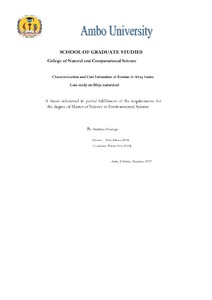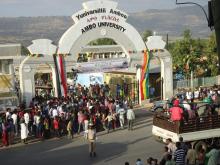Resource information
In Ethiopia, soil erosion during the rainy season constitutes a sever threat to the national economy. The study site, head of the Abay basin is among the heavily affected areas, which is a peril for the crop water productivity. Most studies conducted in the country are focused on quantification of sediment and lack of specific information about temporal and spatial variability of sediment and its associated plant nutrients loss. This study was, therefore undertaken to quantify and characterize sediment and runoff water along with calculating the onsite economic cost of erosion in terms of its associated loss of plant nutrients. To estimate plant nutrient and sediment concentration, depth integrated runoff samplings were made at three monitoring stations in which two from sub catchments and one at the outlet of the watershed. The ten consecutive day samples were bulked on decade basis for each station and then both physical and chemical parameters of the sediment and runoff samples were analyzed at Ambo University. The cost of erosion in the watershed was calculated based on Productivity change approach focusing on available plant nutrients of N and P losses. The average suspended sediment concentration during the rainy season was 3.0+1.1, 2.2+1.3 and 1.4+ 0.9 g L-1 in which the areaspecific sediment yield was ranges from 74 t km-2, 248 t km-2 and 604 t km-2at Melka, Galesssa and Kollu monitoring stations respectively. The result revealed that both sediment and nutrient concentrations were highly variable both in space and time; in which lower concentration occurred towards the end of the rainy season than at the beginning in each station. Based on the complex interaction of multiple natural and anthropogenic factors; the Ridge of Meja River was the most critical source areas for the loss of sediment and associated plant nutrients in the watershed during the rainy period. The correlation matrix between erosion process parameters revealed that both sediment texture and discharge had strongly significant correlated with sediment and nutrient losses. Nutrients loss associated with the sediment and runoff water was a challenge for the productivity and survival of Meja watershed as depicted by an estimated cost on farmer’s 595, 510 and 2475 birr/ha from the sub catchments of Melka, Kollu and Galessa stations respectively due to the loss of major crop nutrients of Nitrogen (N) and Phosphorus (P) only in one rainy season.



